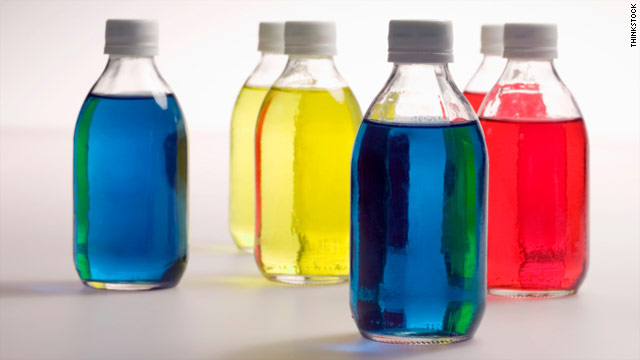
A Food and Drug Administration advisory committee decided Thursday there is insufficient evidence to support a link between artificial dyes in foods and children with ADHD. The committee will make no recommendation to ban or regulate dye additives found in food products. But the committee did stress that there seems to be a trend with artificial dyes and side effects in children and that more research is needed.
Over the past two days the committee has heard testimony on dyes and how they cause some children to show signs of hyperactivity. The question before the committee: Is there enough evidence to connect artificial dyes and hyperactivity and, if so, should it recommend that the FDA strengthen its regulations on these ingredients? The committee's response seems to be "Not now."
According to the experts who testified, European companies already are dropping dyes including Blue #1, Yellow #5 and #6 and others and substituting natural colorings for them. But the United States still allows artificial dyes, mostly for aesthetic reasons, not for taste, the experts say.
There are eight dyes now being used in the United States; Citrus Red 2, Red 3, Red 40, Blue 1 & 2, Green 3 and Yellow 5 & 6. They can be found in numerous food products from packaged macaroni and cheese to Easter candy.
Critics had called for either a ban or more explicit labeling. “Why are these dyes in these foods anyway?” asked Michael Jacobsen, executive director of the Center for Science and the Public Interest, a watchdog group on nutrition and food safety. “I would push for having them taken out completely. But if that can’t be done, why not warn the public and parents that these dyes could have some effects?”
The idea that dyes in food causes ADHD was first noted in "Why Your Child is Hyperactive," a book written by Dr. Benjamin Feingold in 1975. The eating style described in the book became known as the Feingold Diet. He found if you eliminated artificial food dyes and additives in American diets, cases of hyperactivity in children, later defined as ADHD, would decline. But reviews of the data found that the correlation between dyes and hyperactivity were inconsistent.
Although numerous data have been collected on food dyes and hyperactivity in kids during the past decade, critics say the design of the studies has been weak. They note many of the studies were performed on small groups– many involved no more than 25 children. They also noted that much of the observation data (how the child acted) was reported by parents and not by clinicians. And they pointed out that most of the dyes tested were combined into a dye mixture and not tested individually.
The most recent studies to bring food dyes and ADHD back to the public eye was a 2007 project conducted by researchers at the University of Southampton in the United Kingdom. It showed that artificial food dyes along with sodium benzoate (a white crystalline salt used as a food preservative) increased ADHD symptoms in both hyperactive and non-hyperactive children. That study was followed up by another paper in 2010 by the same researchers who looked at the connection between food dyes, ADHD and histamine, a chemical that’s produced in the brain when the body is having an allergic reaction.
“We found mixtures of certain artificial colors together with sodium benzoate preservative in the diet increased the average level of hyperactivity in 3 and 8/9 year old children in the general population,” Dr. Jim Stevenson, a professor at the School of Psychology at the University of Southampton, and lead author of the study, testified Wednesday.
During the hearing, parents from all over the United States shared stories about their children with the committee. Renee Shutters, from Jamestown, New York, said her 5-year-old ,Trenton, who at the time was in preschool, was an unhappy child. “He just wasn’t comfortable with himself,” said Shutters. But after talking to another parent who said her child was having behavioral issues because he was allergic to a food dye, Shutters took action. “I went through my pantry and removed everything with dyes," declared Shutters.
“Now,” Shutters says, “Trenton is fine. After two days there was a huge change. Two weeks later he felt different, much happier and six weeks later, he was a new child.”
“To give my child an artificial dye would be child abuse!” exclaimed Maureen Lamm, a doctor and mother of three from Kennesaw, Georgia, a suburb of Atlanta. “He suffers that much when he eats foods with certain dyes.” Lamm has become so involved she offers a website, www.momsabcs.com, to parents to warn them about dye allergies.
But the FDA’s evaluation of studies on color additives and ADHD found there was very little strong evidence in any of these studies that showed dyes were the primary reason for a child’s hyperactivity.
“There were other factors in most of these studies that could have been the reason or could have gone hand in hand with the dyes to create these problems in these particular children, including preservatives,”said Jason August with the FDA’s Office of Food Additive Safety.
And the International Food Information Council, which is supported primarily by broad-based food, beverage and agricultural industries, says the science isn’t there.
“Without sufficient scientific evidence that a causal link truly exists between food colors and hyperactivity in children, communications that suggest a link could have unintended consequences, including unnecessarily frightening consumers about safe ingredients that are consumed every day,” said David Schmidt, president and CEO of IFIC.
After lengthy discussion the committee made its decision based on the FDA’s evaluation of study data, as well as testimony from researchers. It was the weakness of the studies, and the lack of data, that caused the committee to ask for more research and delay action on artificial dyes.
Although the committee only makes recommendations to the FDA, the agency usually follows those recommendations.

.png)




No comments:
Post a Comment